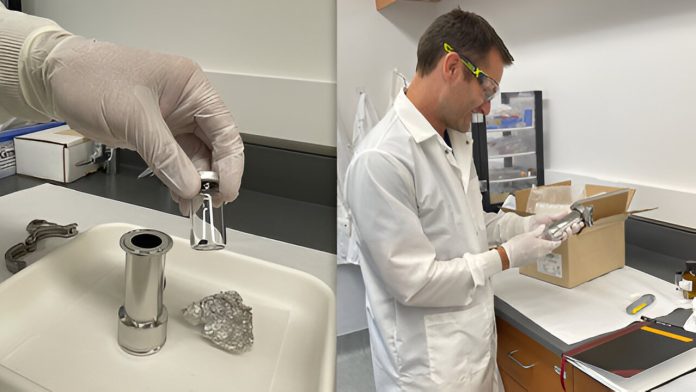
Inside a vacuum-packed container within a FedEx box lies a piece of ancient history: a small sample from the Bennu asteroid.
This 120-milligram sample holds valuable information about the early solar system, how planets formed, and possibly even the origins of life on Earth.
Scientists at Lawrence Livermore National Laboratory (LLNL) recently received this sample from Bennu, a small, carbon-rich asteroid that passes close to Earth every six years.
Bennu was the target of NASA’s OSIRIS-REx mission, which aimed to collect an asteroid sample and bring it back to Earth. The spacecraft successfully returned last fall, landing in Utah with about 120 grams of Bennu on board.
“We’re going to analyze the composition of different elements to figure out where this asteroid might have formed,” said LLNL scientist Jan Render, one of the team members who opened the box from NASA.
Bennu, about one-third of a mile wide, is an ancient relic of our solar system’s early days, having witnessed more than 4.5 billion years of history. Scientists believe Bennu’s current composition was established within 10 million years of the solar system’s formation.
Preliminary data suggest that Bennu likely formed in the outer solar system beyond Jupiter. It probably broke off from a much larger carbon-rich asteroid 700 million to 2 billion years ago, spent time in the main asteroid belt between Mars and Jupiter, and has since drifted closer to Earth.
Because Bennu’s materials are so pristine and have never been heated above ~150°C, it may contain organic molecules similar to those that could have sparked life on Earth.
While the organic molecules will be studied elsewhere, LLNL scientists will focus on analyzing Bennu’s inorganic components to determine when, where, and how the asteroid formed.
“Asteroids are like fossils and can tell us what the solar system was like in the past,” said LLNL scientist Quinn Shollenberger. “We can look back in time to when the sun was being born and how rocky planets formed.”
The team believes Bennu formed at the very start of the solar system, more than 4.5 billion years ago. “This work will allow us to understand where and how this asteroid formed,” said LLNL scientist Greg Brennecka. “Bennu is a snapshot of what the solar system was like over 4.5 billion years ago.”
Bennu’s journey from space to Earth is significant because, unlike meteorites that interact with Earth’s atmosphere and surface, this sample was collected in space and brought back in a pristine condition. “This sample is really important because it was collected in space, sealed, and brought back with no interaction with the terrestrial system at all,” Brennecka explained.
LLNL has a long history in cosmochemistry, the study of extraterrestrial materials. Their research helps understand the origin and evolution of the solar system. The team can measure the age of planetary and meteoritic materials with incredible precision, even with small samples. They have dated various objects, including cometary material, meteorites, and lunar samples.
By applying their techniques to material collected on asteroid return missions, LLNL researchers aim to gain comprehensive insights into the materials from which the solar system formed and how it has evolved. Livermore has also received samples from the asteroid Ryugu (Hayabusa2 mission) and now Bennu (OSIRIS-REx mission).



